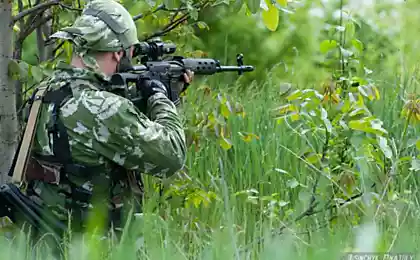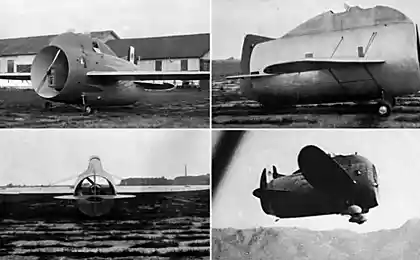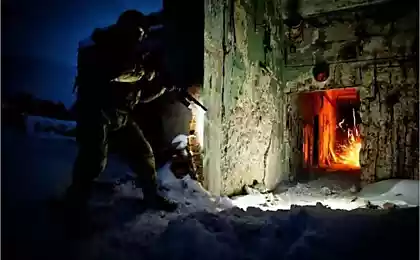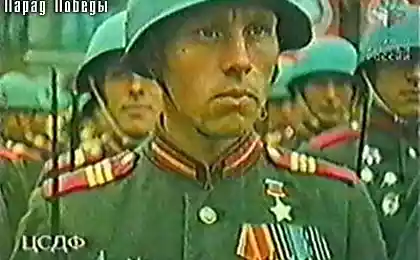912
Weapons of victory: from a grenade to fighter
Preface:
Ladies and Gentlemen! After years of browsing chips, I decided to create my first post and share an interesting article about the creation of weapons with which our veterans forged Great Victory.
Unfortunately, this position does not reach even half of the achievements of our designers in this field. If you like this post, then the following will be more extensive and detailed (there is a desire to make a post about the famous Mosinku, CT, etc.).
And in fact the article itself.
He argued that the Soviet Union was defeated in World War II more numbers than skill. However, to put weapons into the hands of every soldier as a large army - this is the greatest skill for designers, workers and employees of the rear.
By comparing the performance characteristics of the Soviet and German technology of World War II, most of the historians come to a conclusion on unique technical superiority of the Third Reich. At the same time praised the destructive power, rate of fire, accuracy, range and security sighting German weapons, but such important factors as the volume and value of production, maintainability, and ease of development, as a rule, are carried out of the brackets. Distributed and an opinion that the victory over the fascist invaders, we must first of all numerical superiority of Soviet troops. His supporters often forget that the Soviet soldiers did not fight with their bare hands. Every soldier, most of them war caught by surprise, it was necessary to put up a simple and effective weapon.
In the short time to develop a competitive weapon that can be trusted to yesterday's schoolchildren, produce and mend "in an open field" - is almost an impossible task, which afford only the really talented designer. In terms of engineering thought only the most massive weapons can be called a truly technologically advanced. And despite the external roughness and simplicity, these are the types of weapons have become a real weapon of our victory. T-34 tank
Designer: MI Cat Produced during the war: over 35 000 copies
Perhaps the most recognized symbol of victory - is the legendary "Thirty," the most massive tank in the world. The huge scale of production made possible by the highest technological design of the tank, the manufacturing process is perfected throughout the war. It is in the production of T-34 was first introduced automated welding armor plates. By the end of the war (after the installation of a new tower with 85-mm cannon) tank is definitely exhausted all the resources of modernization, but even then, the production of more modern machines were not profitable, because the T-34 took the numerical advantage. In our time, often compared the two most famous tank - a Soviet T-34 and the German Pz.VI «Tiger». The contending parties lead many arguments in favor of each of these machines. In fact unfair to compare these tanks, as it were machines of different "weight categories" are carried out on the battlefield different tasks. "Thirty" was intended primarily to support the attacking infantry. Her 76-mm cannon F-34 had limited opportunities against heavy tanks, but admirably with lightly armored targets, calculations antitank guns and infantry. Shrapnel shot of F-34 was much more effective at the same gun KwK36.L / 56 installed on the "Tiger", an instrument that was intended primarily to defeat armored vehicles. In fact, the "Tiger" was a high-tech "anti" instrument surpasses not only performance, but also on the cost of the many special SAU - "tank destroyers". Thus, Tiger would be fair to compare with the Soviet heavy tank KV-85 and IS-2. As the experience of the war, at a comparable protection and firepower of our tanks we have won in the mobility and simplicity, while the German cars have better optics and a much higher quality of manufacturing.

Hand grenade RG-42.
Designer: SG Korshunov
One of the most ingenious and thus became effective weapons grenade RG-42. Its uniqueness lies in the fact that a constructive body grenade was a bit ordinary tin can resize. Only instead of condensed milk in it fit fragmentation shirt thick rolled steel strip with a notch and an explosive charge. Blaster served as a standard fuse UZRG, production of which has already been put on stream. Production of RG-42 might be adjusted to any canning factory. At the same fighting qualities grenade did not concede more complex and expensive counterparts. In China, analogue RG-42 is available until now.

Anti-personnel grenade RG-42 is designed to engage enemy personnel shrapnel. It refers to the type of offensive grenades: the radius of separation of fragments smaller than the average distance of the throw. However, in practice, a grenade was quite dangerous, and tried to throw her out of hiding, armored personnel carriers and tanks. The gap occurs after 3 grenades, 2-4, 2 seconds after the soldiers to release her from the hands of

Divisional Gun ZIS-3.
Designer: VG Grabin Produced during the war: more than 103 000 copies
The most widespread weapon in the artillery during the war became divisional gun ZIS-3 design Basil Grabina. Conveyor production of these weapons has been established at several factories (parent company - Gorky artillery factory number 92). Launched more than 103,000 copies, this gun was a real masterpiece of technology and reliability. Fire from guns Grabinsky could keep any Soviet projectiles caliber 76 mm 2, which greatly facilitates the supply of artillery batteries. It should be recognized that the combat characteristics of the ZIS-3 inferior to their foreign counterparts (in particular, the British 17-pounder gun), but in terms of convenience and simplicity Soviet gun had no equal. Given the low level of divisional artillery and tough operating conditions, it was a very valuable advantage - even major repairs can be carried out by the calculation. On the basis of ZIS-3 and a light tank T-70 was created self-propelled artillery Su-76. Let not find fame and respect among tankers (but out thousands), Su-76 fire and armor could in the worst period of the war to support the infantry on the battlefield.
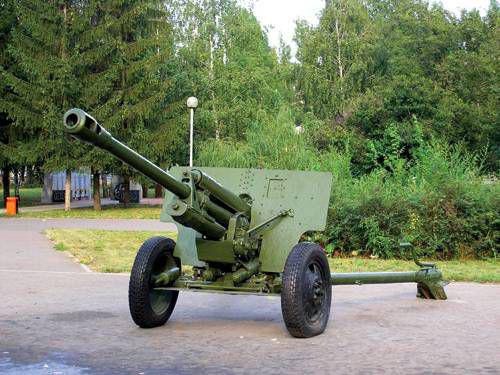
Submachine gun PCA
Designer: GS Shpagin Produced during the war: about 6 million copies
During World War II, have been widely used submachine guns, automatic weapons, which uses a pistol cartridge. Sub-machine guns appeared in 1920 and quickly gained popularity thanks to the efficiency and convenience. Initially, the Soviet Union was against adopting SMGs Stalin considered them "gangster weapons", unworthy of the Red Army. However, experience in the Winter War of 1939-40, the dramatically changed the attitude towards this kind of weapons, and in 1940 sub-machine gun Degtyarev PPD was adopted. During the operation to identify and design significant disadvantages: unreliable supply of ammunition and high complexity of manufacturing. These disadvantages are eliminated Degtyareva student, George Shpagin in his submachine gun PPSh-41. This weapon was used by one of the most simple and reliable scheme of automation - a free gate. The shot is as follows: the shooter removes the bolt in the rear position, thus compressing the back-mainspring. When you press the shutter spring pushes the bolt forward while dosylaya cartridge from the magazine and impaling cap. The main difference from the PCA PDP was that that shpaginskom weapons almost all parts, except for the barrel and stock, manufactured cold formed - one of the cheapest and most productive ways of working metal. During the war, was released about 6 million PCA, while the German MP-40 machine (often mistakenly called "Schmeisser") - a total of about 934,000 units. Due to the very successful cartridge 7, 62 x 25 (the same used in the TT pistol) bullet fired from PCA had high lethal effect, and muzzle compensator (beveled edge housing) increased shooting accuracy by 60% compared with the PPD. An important advantage was the ease of dismantling and possibility of fast replacing any parts. An interesting fact is that the Wehrmacht was officially armed with PCA, converted by 9-mm cartridge.

IL-2 Sturmovik.
Designer: SV Ilyushin Produced during the war: over 36 000 copies
Il-2 was developed in CDB-57 under the direction of Sergei Ilyushin. It was a machine, specialized to attack ground targets with a small height. The main feature of the design - the use of the carrier hulls, closes the pilot and vital organs of the aircraft. Armor IL-2 is not just protected from small-caliber shells and bullets, but also served as a part of the primary structure of the fuselage, thereby able to achieve notable weight savings. The famous "Flying Tank" has a very dramatic story. Initially it planned to make the two-seater plane, but because of the weak engine Ilyushin was unable to meet the tactical and technical requirements, and was forced to give up the hand that covers the rear hemisphere of the aircraft. Single "Il" was supplied to the troops on the eve of the war, and although its effectiveness against tanks and convoys was quickly confirmed, the lack of protection behind the plane made completely defenseless against enemy fighters. Losses in the assault were often so great that the title of Hero of the Soviet Union was assigned the pilot to ten sorties (instead of the usual one hundred). Only in July 1942 Double IL-2M passed state tests and was launched in the series. Due to the fact that the production of armor for the aircraft has been established at several plants, to control the quality it was very difficult and welded body aircraft checked for defects shooting from large-caliber machine gun. Prior to 1944, the structure of IL-2 was widely used tree - while saving scarce duralumin. Although bronekorobka perfectly fulfills its function, it has been cases when "Elah" came back to the airport from the badly damaged tail. Throughout the war, "Elah" remained a major tool in the fight against the German tanks. Their high efficiency is achieved through the use of cassette bombs PTAB-2, 5. The tiny bomb (IL-2 took four container with 48 bombs) dropped a volley on the accumulation of technology. Armor-piercing PTAB was about 70 mm - this was more than enough to destroy a tank top. It is believed that success in the Battle of Kursk was achieved largely due to the actions of stormtroopers Germans began to avoid the accumulation of their troops, and coordinate the work of scattered parts was much more difficult. The Germans called IL-2 "concrete bomber."
May 2009
Author: Stepan Zhilin

Source: www.popmech.ru
Ladies and Gentlemen! After years of browsing chips, I decided to create my first post and share an interesting article about the creation of weapons with which our veterans forged Great Victory.
Unfortunately, this position does not reach even half of the achievements of our designers in this field. If you like this post, then the following will be more extensive and detailed (there is a desire to make a post about the famous Mosinku, CT, etc.).
And in fact the article itself.
He argued that the Soviet Union was defeated in World War II more numbers than skill. However, to put weapons into the hands of every soldier as a large army - this is the greatest skill for designers, workers and employees of the rear.
By comparing the performance characteristics of the Soviet and German technology of World War II, most of the historians come to a conclusion on unique technical superiority of the Third Reich. At the same time praised the destructive power, rate of fire, accuracy, range and security sighting German weapons, but such important factors as the volume and value of production, maintainability, and ease of development, as a rule, are carried out of the brackets. Distributed and an opinion that the victory over the fascist invaders, we must first of all numerical superiority of Soviet troops. His supporters often forget that the Soviet soldiers did not fight with their bare hands. Every soldier, most of them war caught by surprise, it was necessary to put up a simple and effective weapon.
In the short time to develop a competitive weapon that can be trusted to yesterday's schoolchildren, produce and mend "in an open field" - is almost an impossible task, which afford only the really talented designer. In terms of engineering thought only the most massive weapons can be called a truly technologically advanced. And despite the external roughness and simplicity, these are the types of weapons have become a real weapon of our victory. T-34 tank
Designer: MI Cat Produced during the war: over 35 000 copies
Perhaps the most recognized symbol of victory - is the legendary "Thirty," the most massive tank in the world. The huge scale of production made possible by the highest technological design of the tank, the manufacturing process is perfected throughout the war. It is in the production of T-34 was first introduced automated welding armor plates. By the end of the war (after the installation of a new tower with 85-mm cannon) tank is definitely exhausted all the resources of modernization, but even then, the production of more modern machines were not profitable, because the T-34 took the numerical advantage. In our time, often compared the two most famous tank - a Soviet T-34 and the German Pz.VI «Tiger». The contending parties lead many arguments in favor of each of these machines. In fact unfair to compare these tanks, as it were machines of different "weight categories" are carried out on the battlefield different tasks. "Thirty" was intended primarily to support the attacking infantry. Her 76-mm cannon F-34 had limited opportunities against heavy tanks, but admirably with lightly armored targets, calculations antitank guns and infantry. Shrapnel shot of F-34 was much more effective at the same gun KwK36.L / 56 installed on the "Tiger", an instrument that was intended primarily to defeat armored vehicles. In fact, the "Tiger" was a high-tech "anti" instrument surpasses not only performance, but also on the cost of the many special SAU - "tank destroyers". Thus, Tiger would be fair to compare with the Soviet heavy tank KV-85 and IS-2. As the experience of the war, at a comparable protection and firepower of our tanks we have won in the mobility and simplicity, while the German cars have better optics and a much higher quality of manufacturing.

Hand grenade RG-42.
Designer: SG Korshunov
One of the most ingenious and thus became effective weapons grenade RG-42. Its uniqueness lies in the fact that a constructive body grenade was a bit ordinary tin can resize. Only instead of condensed milk in it fit fragmentation shirt thick rolled steel strip with a notch and an explosive charge. Blaster served as a standard fuse UZRG, production of which has already been put on stream. Production of RG-42 might be adjusted to any canning factory. At the same fighting qualities grenade did not concede more complex and expensive counterparts. In China, analogue RG-42 is available until now.

Anti-personnel grenade RG-42 is designed to engage enemy personnel shrapnel. It refers to the type of offensive grenades: the radius of separation of fragments smaller than the average distance of the throw. However, in practice, a grenade was quite dangerous, and tried to throw her out of hiding, armored personnel carriers and tanks. The gap occurs after 3 grenades, 2-4, 2 seconds after the soldiers to release her from the hands of

Divisional Gun ZIS-3.
Designer: VG Grabin Produced during the war: more than 103 000 copies
The most widespread weapon in the artillery during the war became divisional gun ZIS-3 design Basil Grabina. Conveyor production of these weapons has been established at several factories (parent company - Gorky artillery factory number 92). Launched more than 103,000 copies, this gun was a real masterpiece of technology and reliability. Fire from guns Grabinsky could keep any Soviet projectiles caliber 76 mm 2, which greatly facilitates the supply of artillery batteries. It should be recognized that the combat characteristics of the ZIS-3 inferior to their foreign counterparts (in particular, the British 17-pounder gun), but in terms of convenience and simplicity Soviet gun had no equal. Given the low level of divisional artillery and tough operating conditions, it was a very valuable advantage - even major repairs can be carried out by the calculation. On the basis of ZIS-3 and a light tank T-70 was created self-propelled artillery Su-76. Let not find fame and respect among tankers (but out thousands), Su-76 fire and armor could in the worst period of the war to support the infantry on the battlefield.

Submachine gun PCA
Designer: GS Shpagin Produced during the war: about 6 million copies
During World War II, have been widely used submachine guns, automatic weapons, which uses a pistol cartridge. Sub-machine guns appeared in 1920 and quickly gained popularity thanks to the efficiency and convenience. Initially, the Soviet Union was against adopting SMGs Stalin considered them "gangster weapons", unworthy of the Red Army. However, experience in the Winter War of 1939-40, the dramatically changed the attitude towards this kind of weapons, and in 1940 sub-machine gun Degtyarev PPD was adopted. During the operation to identify and design significant disadvantages: unreliable supply of ammunition and high complexity of manufacturing. These disadvantages are eliminated Degtyareva student, George Shpagin in his submachine gun PPSh-41. This weapon was used by one of the most simple and reliable scheme of automation - a free gate. The shot is as follows: the shooter removes the bolt in the rear position, thus compressing the back-mainspring. When you press the shutter spring pushes the bolt forward while dosylaya cartridge from the magazine and impaling cap. The main difference from the PCA PDP was that that shpaginskom weapons almost all parts, except for the barrel and stock, manufactured cold formed - one of the cheapest and most productive ways of working metal. During the war, was released about 6 million PCA, while the German MP-40 machine (often mistakenly called "Schmeisser") - a total of about 934,000 units. Due to the very successful cartridge 7, 62 x 25 (the same used in the TT pistol) bullet fired from PCA had high lethal effect, and muzzle compensator (beveled edge housing) increased shooting accuracy by 60% compared with the PPD. An important advantage was the ease of dismantling and possibility of fast replacing any parts. An interesting fact is that the Wehrmacht was officially armed with PCA, converted by 9-mm cartridge.

IL-2 Sturmovik.
Designer: SV Ilyushin Produced during the war: over 36 000 copies
Il-2 was developed in CDB-57 under the direction of Sergei Ilyushin. It was a machine, specialized to attack ground targets with a small height. The main feature of the design - the use of the carrier hulls, closes the pilot and vital organs of the aircraft. Armor IL-2 is not just protected from small-caliber shells and bullets, but also served as a part of the primary structure of the fuselage, thereby able to achieve notable weight savings. The famous "Flying Tank" has a very dramatic story. Initially it planned to make the two-seater plane, but because of the weak engine Ilyushin was unable to meet the tactical and technical requirements, and was forced to give up the hand that covers the rear hemisphere of the aircraft. Single "Il" was supplied to the troops on the eve of the war, and although its effectiveness against tanks and convoys was quickly confirmed, the lack of protection behind the plane made completely defenseless against enemy fighters. Losses in the assault were often so great that the title of Hero of the Soviet Union was assigned the pilot to ten sorties (instead of the usual one hundred). Only in July 1942 Double IL-2M passed state tests and was launched in the series. Due to the fact that the production of armor for the aircraft has been established at several plants, to control the quality it was very difficult and welded body aircraft checked for defects shooting from large-caliber machine gun. Prior to 1944, the structure of IL-2 was widely used tree - while saving scarce duralumin. Although bronekorobka perfectly fulfills its function, it has been cases when "Elah" came back to the airport from the badly damaged tail. Throughout the war, "Elah" remained a major tool in the fight against the German tanks. Their high efficiency is achieved through the use of cassette bombs PTAB-2, 5. The tiny bomb (IL-2 took four container with 48 bombs) dropped a volley on the accumulation of technology. Armor-piercing PTAB was about 70 mm - this was more than enough to destroy a tank top. It is believed that success in the Battle of Kursk was achieved largely due to the actions of stormtroopers Germans began to avoid the accumulation of their troops, and coordinate the work of scattered parts was much more difficult. The Germans called IL-2 "concrete bomber."
May 2009
Author: Stepan Zhilin

Source: www.popmech.ru











